Abstract
Purpose
The aim of this study is to investigate the clinical performance and safety of Zimmer® natural nail cephalomedullary nail (ZNN CM nail) in the treatment of proximal femur fractures.
Materials and Methods
The following research was conducted as a prospective, non-comparative, single center outcome study. Upon providing written informed consent, enrolled patients’ data were collected and analyzed. Postoperative follow-up visits were scheduled at 6 weeks, 3 months, 6 months, and 1 year. Follow-up evaluation included radiographic assessment, physical examination, and quality of life and adverse events reports.
Results
Thirty-nine patients were available for evaluation at one year postoperative. The patients reported the mean EuroQol-5 Dimension score increased after surgery: from 0.4 points at discharge (n=49) to 0.6 points at 1-year post-surgery (n=39). The mean Harris hip score also increased after surgery: from 56.3 points at discharge (n=49) to 72.1 points at 1 year (n=12). Bone union was seen in 64% (n=16) in 6 months and 95% (n=37) in 1 year.
References
1. Burge R, Dawson-Hughes B, Solomon DH, Wong JB, King A, Tosteson A. Incidence and economic burden of osteoporosis-related fractures in the United States, 2005–2025. J Bone Miner Res. 22:465–475. 2007.

2. Center JR, Nguyen TV, Schneider D, Sambrook PN, Eisman JA. Mortality after all major types of osteoporotic fracture in men and women: an observational study. Lancet. 353:878–882. 1999.

3. Lenich A, Vester H, Nerlich M, Mayr E, Stöckle U, Füchtmeier B. Clinical comparison of the second and third generation of intramedullary devices for trochanteric fractures of the hip: Blade vs screw. Injury. 41:1292–1296. 2010.
4. Kuzyk PR, Lobo J, Whelan D, Zdero R, McKee MD, Schemitsch EH. Biomechanical evaluation of extramedullary versus intramedullary fixation for reverse obliquity intertrochanteric fractures. J Orthop Trauma. 23:31–38. 2009.

5. Albareda J, Laderiga A, Palanca D, Paniagua L, Seral F. Complications and technical problems with the gamma nail. Int Orthop. 20:47–50. 1996.

6. Butt MS, Krikler SJ, Nafie S, Ali MS. Comparison of dynamic hip screw and gamma nail: a prospective, randomized, controlled trial. Injury. 26:615–618. 1995.

7. Herrera A, Domingo LJ, Calvo A, Martínez A, Cuenca J. A comparative study of trochanteric fractures treated with the Gamma nail or the proximal femoral nail. Int Orthop. 26:365–369. 2002.
8. Johnson LJ, Cope MR, Shahrokhi S, Tamblyn P. Measuring tip-apex distance using a picture archiving and communication system (PACS). Injury. 39:786–790. 2008.

9. Corrales LA, Morshed S, Bhandari M, Miclau T 3rd. Variability in the assessment of fracture-healing in orthopaedic trauma studies. J Bone Joint Surg Am. 90:1862–1868. 2008.

11. Hardy DC, Descamps PY, Krallis P, et al. Use of an intramedullary hip-screw compared with a compression hip-screw with a plate for intertrochanteric femoral fractures. A prospective, randomized study of one hundred patients. J Bone Joint Surg Am. 80:618–630. 1998.

12. Leung KS, So WS, Shen WY, Hui PW. Gamma nails and dynamic hip screws for peritrochanteric fractures. A randomised prospective study in elderly patients. J Bone Joint Surg Br. 74:345–351. 1992.

13. Rosenblum SF, Zuckerman JD, Kummer FJ, Tam BS. A biomechanical evaluation of the Gamma nail. J Bone Joint Surg Br. 74:352–357. 1992.

14. McKibbin B. The biology of fracture healing in long bones. J Bone Joint Surg Br. 60:150–162. 1978.

15. Radford PJ, Needoff M, Webb JK. A prospective randomised comparison of the dynamic hip screw and the gamma locking nail. J Bone Joint Surg Br. 75:789–793. 1993.

16. Halder SC. The Gamma nail for peritrochanteric fractures. J Bone Joint Surg Br. 74:340–344. 1992.

17. Park JH, Park JW, Wang JH, Lee JW, Lee JI, Kim JG. Treatment of intertrochanteric fracture: comparison of proximal femoral nail and proximal femoral nail A. Korean Soc Fract. 21:103–109. 2008.

18. Shin DK, Kwun KW, Kim SK, Lee SW, Choi CH, Kim KM. Proximal femoral nail(PFN) for femur intertrochanteric fracture. J Korean Fract Soc. 15:328–335. 2002.

19. Leung KS, Procter P, Robioneck B, Behrens K. Geometric mismatch of the Gamma nail to the Chinese femur. Clin Orthop Relat Res. 323:42–48. 1996.

20. Hwang JH, Oh JK, Han SH, Shon WY, Oh CW. Mismatch between PFNa and medullary canal causing difficulty in nailing of the pertrochanteric fractures. Arch Orthop Trauma Surg. 128:1443–1446. 2008.

21. Pu JS, Liu L, Wang GL, Fang Y, Yang TF. Results of the proximal femoral nail antirotation (PFNA) in elderly Chinese patients. Int Orthop. 33:1441–1444. 2009.

22. Akan K, Cift H, Ozkan K, Eceviz E, Tasyikan L, Eren A. Effect of osteoporosis on clinical outcomes in intertrochanteric hip fractures treated with a proximal femoral nail. J Int Med Res. 39:857–865. 2011.

23. D'Arrigo C, Carcangiu A, Perugia D, et al. Intertrochanteric fractures: comparison between two different locking nails. Int Orthop. 36:2545–2551. 2012.
24. Vaquero J, Munoz J, Prat S, et al. Proximal Femoral Nail Anti-rotation versus Gamma3 nail for intramedullary nailing of unstable trochanteric fractures. A randomised comparative study. Injury. 43(Suppl 2):S47–54. 2012.

25. Simmermacher RK, Ljungqvist J, Bail H, et al. The new proximal femoral nail antirotation (PFNA) in daily practice: results of a multicentre clinical study. Injury. 39:932–939. 2008.

Fig. 1.
(A) Hip antero-posterior (AP) view of left intertrochanteric fracture immediately postoperation. Medial and lateral (LAT) cortex fracture gap at the fracture site is depicted by white arrows. (B) Hip left LAT view of intertrochanteric fracture immediately postoperation. Anterior and posterior cortex fracture gap at the fracture site is depicted by white arrows. (C) Hip AP view of left intertrochanteric fracture 6 months postoperation. Medial cortex shows no fracture gap (white triangles) and callus formation is observed. (D) Hip left LAT view of femur intertrochanteric fracture 6 months postoperation. Anterior and posterior cortex shows no fracture gap (white triangles) and callus formation is observed.
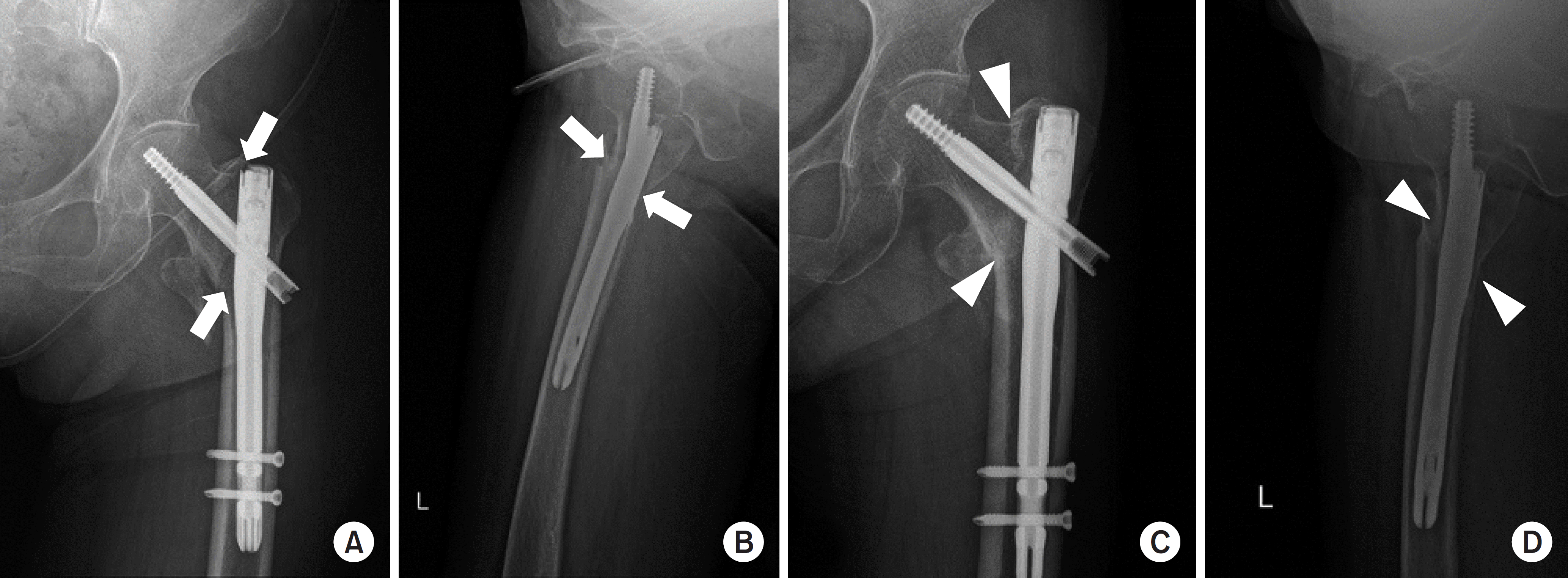
Fig. 2.
Patient enrollment and follow-up flow chart. This study involved intertrochanteric or subtrochanteric fractures in 39 patients requiring cephalomedullary nailing. FUP: follow-up percentage.
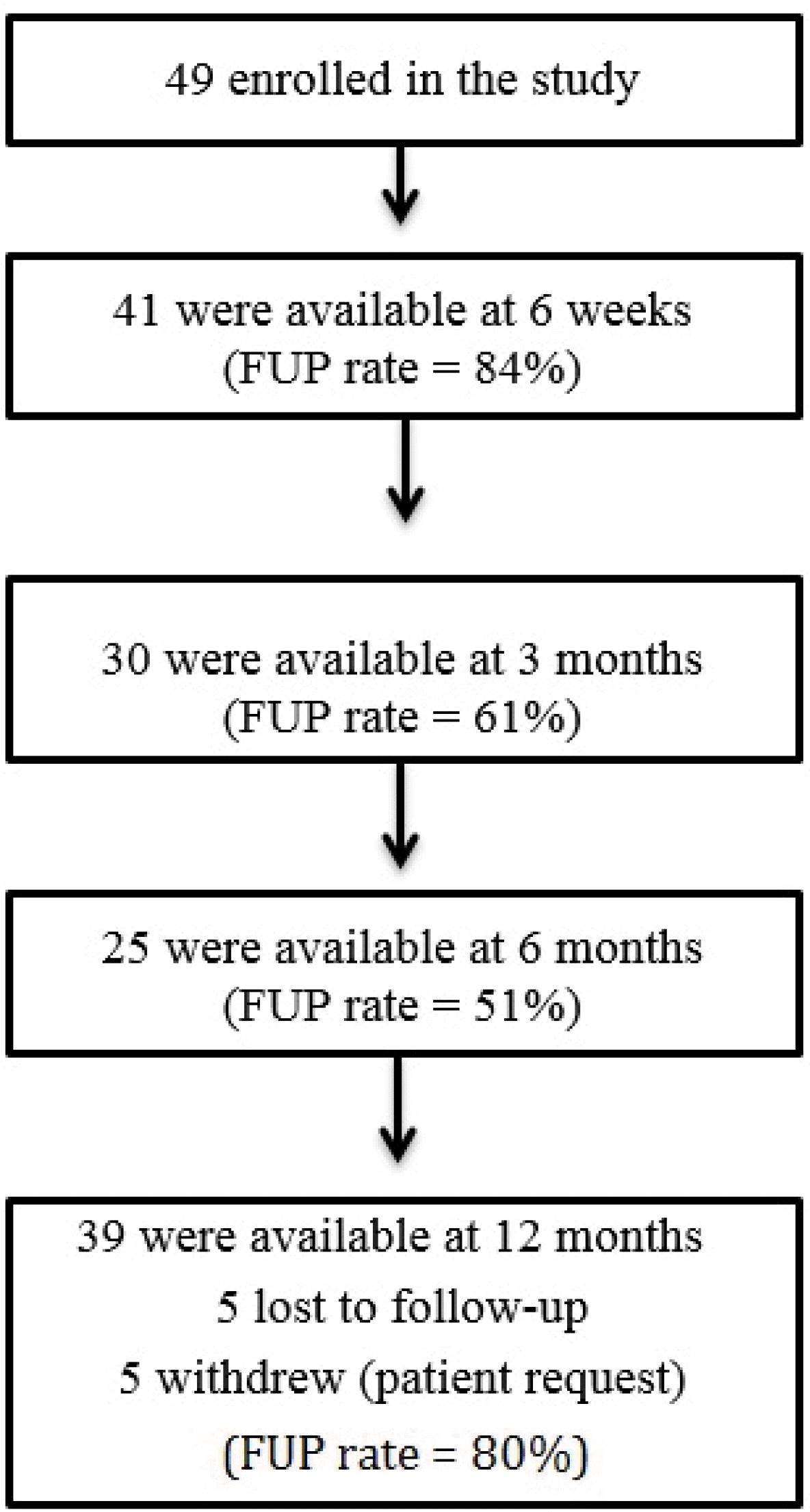
Fig. 3.
Mean EuroQol-5 Dimension (EQ-5D) score. Mean value of EQ-5D score measured in outpatient clinic using questionnaires at each follow-up period. Scores tend to increase from the EQ-5D baseline over time.
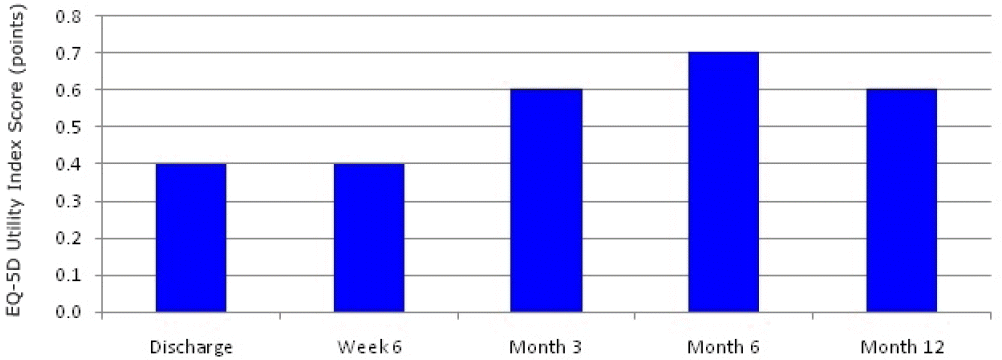
Fig. 4.
Mean Harris hip score (HHS). Mean value of HHS measured in outpatient clinic questionnaires at each follow-up period. Scores tend to increase from the HHS baseline over time.
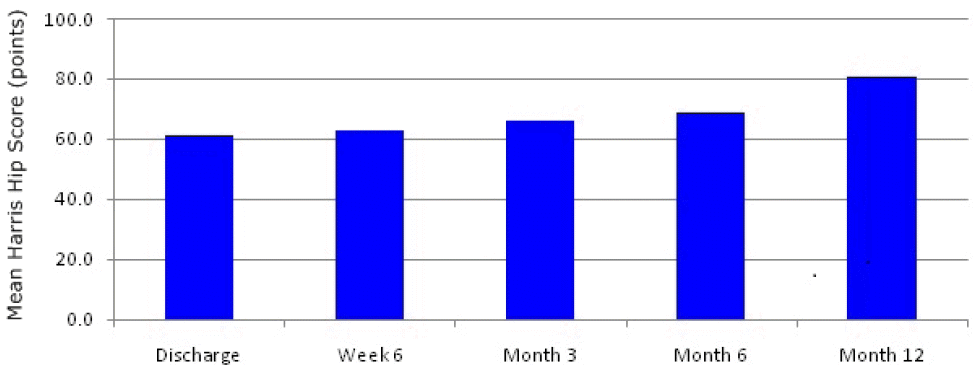
Fig. 5.
Weight bearing without pain. Proportion of weight bearing without pain observed in outpatient clinic at each follow-up period. Proportion of weight bearing without pain increases over the followup period.
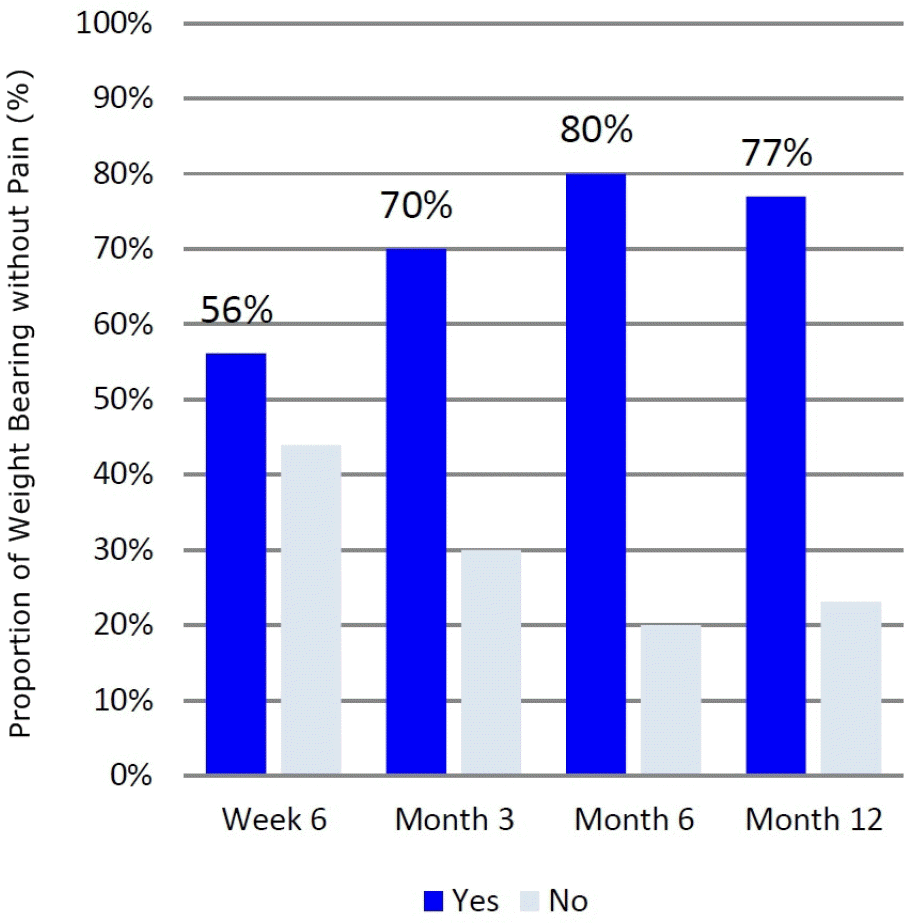
Fig. 6.
Radiologic fracture healing. Radiologic bone union rate confirmed on plain radiographs at each follow-up period. Radiologic bone union rate increases over the follow-up period.
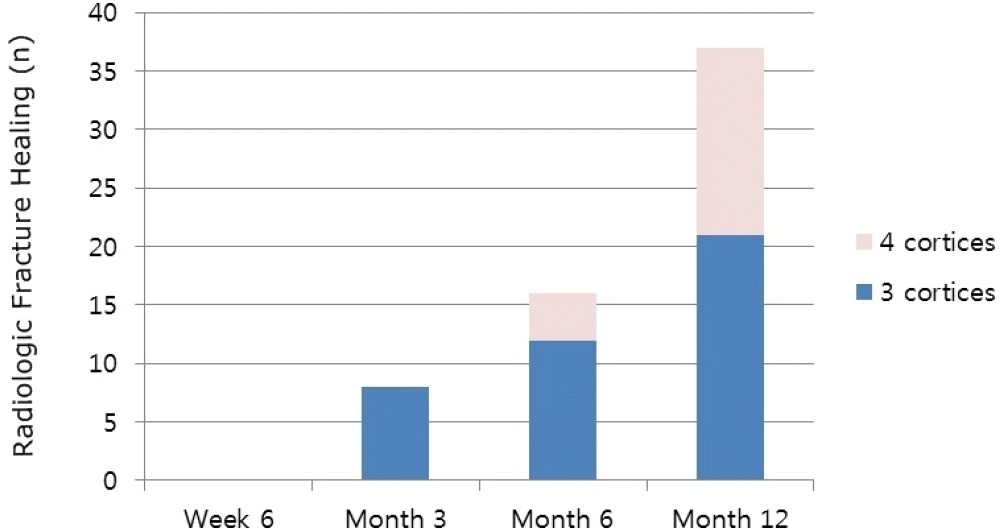
Fig. 7.
Example of the Zimmer natural nail. The proximal diameter of the instrument is reduced from 16 to 15.5 mm as depicted by the dotted outline. Proximal lateralization angle of the instrument is decreased from 5 to 4 degrees as depicted by the square-ended outlines. The caput-columndiaphyseal (CCD) angle is depicted by the dotted-arrow lines.
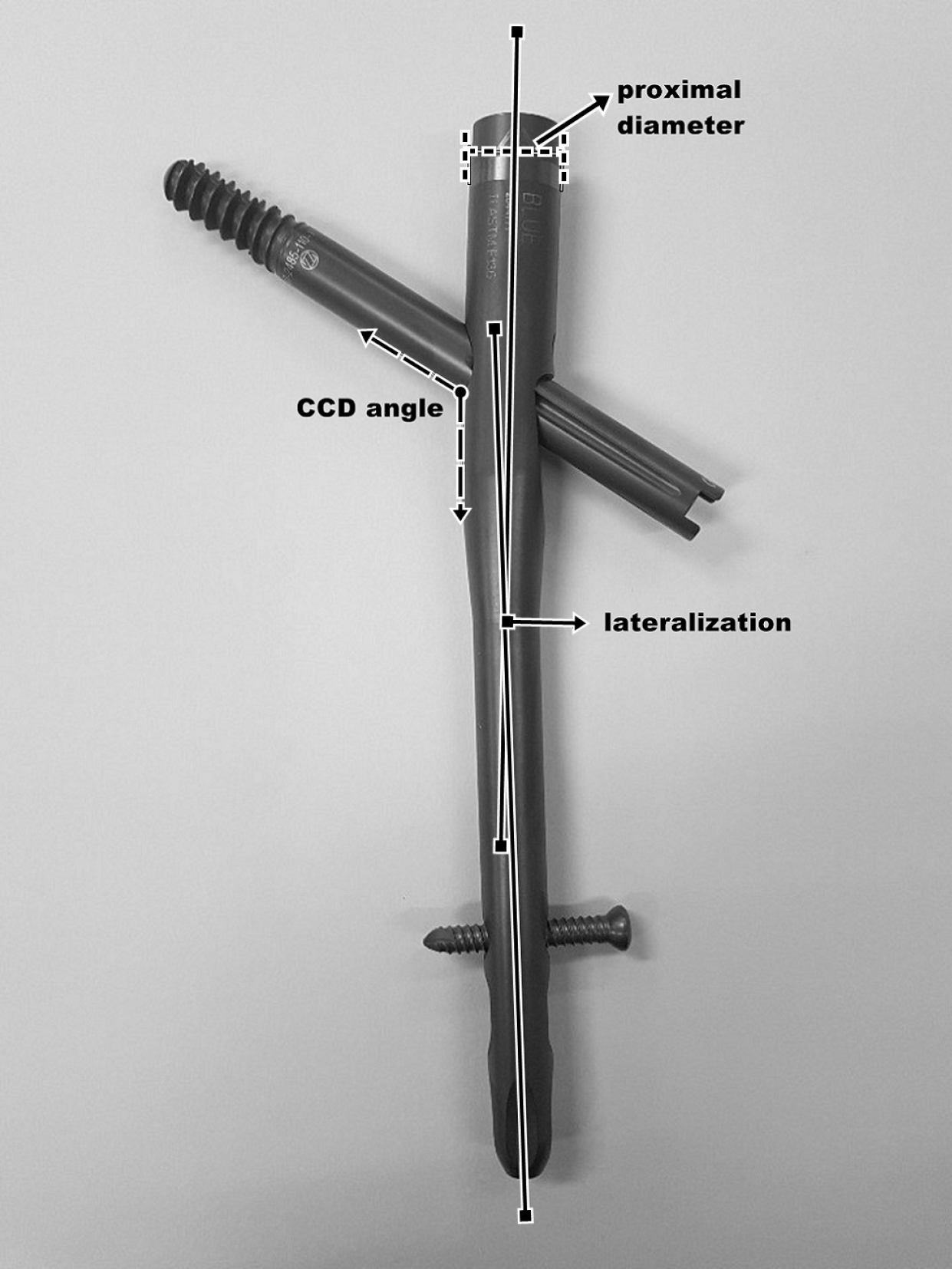
Table 1.
Baseline Characteristics Included in This Study
Table 2.
Intra- and Postoperative Variables




 PDF
PDF ePub
ePub Citation
Citation Print
Print


 XML Download
XML Download